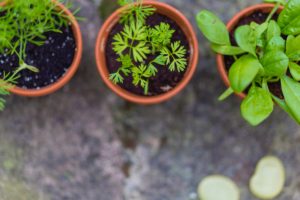Magic potions and elixirs…. sounds like a witches brew or sorcerer’s spell.
Or, a maybe a more contemporary version would be a healing tincture.
The herbs in the garden are plentiful this time of year and they have been a wonderful addition to my cooking. I don’t know why I get such joy from walking outside and picking some fresh herbs to throw into (or onto) a dish that I’ve prepared.
But as the season winds down, thoughts of harvesting and drying the herbs begin to enter my mind. This year however, I’m exploring tinctures so that I can use the healing properties all year long.
I shared how to easily make a tincture below and in the Facebook group, Natural and Alternative Solutions for Health. I would love to have you join my community. 
Which herbs you grow in your garden vary, but here are some commonly grown herbs that can be used as a tincture (uses and doses from Herbs for Health & Healing by Jill Stansbury, ND).
Thyme: use for relief from respiratory symptoms. When used as a tincture, side effects are uncommon but very large doses at once may occasionally promote nausea and a sensation of warmth and perspiration. As a tincture, take 1/2 teaspoon 2-4 times a day.
Sage: use as a digestive aid, antioxidant and antimicrobial agent. There are no reported side effects, but there have been isolated reports that when used in significant amounts, a seizure may be triggered in people with epilepsy; avoid large amounts of sage as a medicinal preparation during pregnancy. As a tincture, take 1/8 to 1/2 teaspoon in a sip of water once or twice a day.
Chamomile, German (not to be confused with Roman chamomile): use for soothing stomach aches and muscle pain. Most people tolerate chamomile well, but many herbalists advise pregnant women to avoid using any herbs they don’t really need. As a tincture, take 30-60 drops, three times a day.
Lemon Balm: use to soothe the nervous system (to relieve stress & anxiety); it has also been credited with antiviral effects, and it seems particularly effective against the herpes virus. There are no commonly reported side effects and no cited precautions and warnings. No dose is provided for tinctures. However, according to Dr. Andrew Weil, adults may take up to 60 drops of a tincture up to twice a day. (You can read more about what Dr. Weil has to say about the therapeutic uses of lemon balm in his article simply called Lemon Balm).
Making Your Own Tincture:
This requires very little effort and a few common kitchen tools. Here is the method that Dr. Stansbury shares in her book:
1.) First clean and pick over fresh herbs, removing any insects or damaged plant material. Remove leaves and flowers from stems and break roots or bark into smaller pieces (of course, you can use dried herbs too).
2.) Cut or chop the plant parts you want to process or chop in a blender (or food processor).
3.) Cover with 80-100 proof vodka. This higher alcohol content is required to extract the constituents of some herbs such as ginger of cayenne.
4.) Puree the plant material and transfer to a glass jar, making sure the alcohol covers the plant material. Any plant material exposed to air can mold or rot.
5.) Store the jar at room temperature out of sunlight and shake the jar everyday.
6.) After 3-6 weeks, strain the liquid with a kitchen strainer, cheesecloth or paper coffee filter. Note that even when you’ve managed to strain out every last bit of plant material, sometimes more particles mysteriously show up after the tincture has been stored. There is no harm in using a tincture that contains a bit of solid debris.
Tinctures will keep for many years without refrigeration.
If you prefer not to use alcohol, you can try making a vinegar and glycerin based tincture.
Unfortunately, Dr Stansbury’s book Herbs for Health & Healing is out of print, but you can find many herbal recipes including tinctures, in this book by Rosemary Gladstar, “Herbal Recipes for Vibrant Health”
Michelle Koe Page is a participant in the Amazon Services LLC Associates Program, an affiliate advertising program designed to provide a means for sites to earn advertising fees by advertising and linking to this website.
